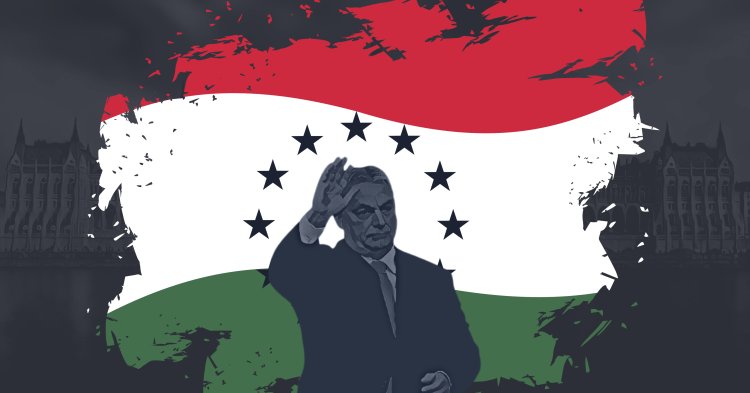When Europeans think of nationalism today, few examples hit as close to home as Orban’s Hungary. What was once a promising prospect for showcasing the success of European integration and western democracy quickly spiralled into what is now one of the EU’s most corrupt member states. The country has been at the centre of repeated spats with the EU over its rule of law violations and, more recently, its refusal to support Ukraine against Russia’s invasion. Orban himself has become infamous as the flagbearer for Eurosceptics across the continent. The so-called “illiberal democracy” which he has built over the past decade has shown just how fragile the democratic transition in Eastern Europe can be, but also serves as a cautionary tale of how the ghosts of a country’s now dead regime can continue to haunt it well into the future.
Empire, Democracy and Everything In Between
The modern state of Hungary, like many of its Central and Eastern European neighbours, shares a long and turbulent history of war, subjugation and resistance. The country traces its origins to the invasions of Central Europe by the nomadic Magyars in the Middle Ages which gave rise to the medieval Kingdom of Hungary. This medieval kingdom would later become a core part of Habsburg Austria-Hungary and, down the line, the independent Kingdom of Hungary, the Soviet-occupied Hungarian People’s Republic, and the modern Third Hungarian Republic. As is common in the region, struggle was a core part of many chapters of Hungarian history. For much of its existence, the Hungarian lands did not have equal rights within Habsburg Austria. The Habsburg monarchy launched a counter-reformation against the predominantly Calvinist population and violently suppressed the 1848 revolution calling for parliamentary democracy, instating martial law until the Austro-Hungarian Compromise of 1867 (Gerrits & Wolffram, 2005). After the Second World War, Hungary was occupied by the Red Army and the Hungarian People’s Republic instituted a totalitarian Stalinist regime, creating one of the Eastern Bloc’s harshest dictatorships (Granville, 2004). This led to the failed Hungarian Revolution of 1956 which was crushed by the Warsaw Pact invasion that followed, resulting in over 200,000 Hungarians fleeing the country (Niessen, 2016) and, down the line, providing a basis for the Revolutions of 1989, ending the communist grip over the country.
These events are important as they paint the picture of a nation with a rich history and unique identity which would come to shape, in varying ways, the current Hungarian state. Once Hungary joined the European Union in 2004, it was hoped that the country, along with the rest of the region, would become a western-style liberal democracy, much like Spain and Greece in the decades prior. After the election of the Second Orban Government, those hopes quickly dissipated, and Hungary has since become the prime example of democratic backsliding and rejection of liberal values in favour of nationalist rhetoric within the EU.
In Search of a Unifying Force
The natural question that arose in Europe, and particularly in Brussels, is how exactly did we get here? Central and Eastern Europe are no strangers to nationalism. While many believed that EU membership would signal the death knell of nationalism, it provided nationalists with an opportunity to reinvent themselves as an opposition to the European project (Fox & Vermeersch, 2010). Throughout the later half of the twentieth century, the communist governments of the Eastern Bloc used the continuous pursuit of a communist utopia as the ideological glue to keep their respective societies in line and justify their oppressive policies. They were framed as necessary means to guide their countries to progress which would, of course, never come. Once that ideological bedrock fell apart in the 1990s, would-be authoritarians found themselves searching for a new founding myth for their coming to power.
The communist regimes created a fertile ground for right-wing nationalism to prosper once they were gone. In most cases, the communist parties themselves were incredibly nationalist, as they based their coming to power as a national people’s struggle (Kemp, 1999). This rewriting of history was needed to justify these governments’ own existence, and in many instances framed their actions as done on behalf of the people, even when done expressively against them (Reynolds, 2020). The endless list of crimes these regimes perpetrated, from the persecution of political rivals and crushing of civil liberties to the suppression of religion, such as the 1956 revolution in Hungary’s case, allowed the right to easily paint itself as a liberal opposition. Once democracy was established, nationalists stressed conservative values and religion as a modern rejection of the totalitarian communist internationalism of the past century. The disastrous transition to a capitalist economy in the 1990s also left deep scars in the region’s psyche, as local elites grew resentful of what they viewed as unjust criticism by western institutions (Kostov, 2019). This period played a key role in the defamation of liberalism and the rejection of western democratic norms by both the general population and the political leadership.
The Rise of the “Illiberal Democracy”
This process was clearly observed in Hungary. Having been known as a leader in democratisation in the 1990s, the second government of Viktor Orban following the 2010 elections led the country down a path of nationalist fervour and a rejection of European values. The Third Hungarian Republic based its existence as a liberal democracy on the struggle for freedom during the revolutions of 1848, 1956 and 1989, and the desire for progress as a dignified part of Europe. Modern Hungary under Viktor Orban is a very different story. The vision which the Fidesz party has set out for the country is that of a proud and independent nation and protector of European Christian values. The nationalist rhetoric has been used by Orban to redefine the nature of the Hungarian nation and justify his vision of its future, setting out his vision of a new, illiberal democracy. In 2000, the first Orban government symbolically moved the Holy Crown of Hungary to the premises of parliament (BBC, 2000). During the European Migrant Crisis, Orban styled himself as a defender of Christianity and opposed allowing asylum seekers into the EU. Similar rhetoric has been used to curtail LGBT+ rights in order to protect family values and hinder further European integration in favour of national sovereignty.
The rhetoric is, of course, merely a political device. Modern Hungary is a republic whose parliament honours a dead monarchy and a Christian nation whose population does not consider religion important for their identity (Pew Research, 2017). The irony of such rhetoric is palpable, but realism is not its goal. The modern Hungarian state had no intrinsic need to resort to nationalism, it already had a liberal basis which it could build upon. The international outlook of the European project left little use for nationalism as the country sought western integration. Its only application has been as an opposition to liberal democracy. Orban has been able to utilise nationalist rhetoric within the (by now) largely Fidesz-controlled media to great effect in order to consolidate his power, framing himself as defending the conservative values of the countryside against the cosmopolitan aspirations of the large city elite (Heydemann & Vodicka, 2017). Much like its communist predecessors, the Hungarian government has used nationalism to justify many of its unsavoury practices. From dismantling the rule of law by attacking the independence of the judiciary to the crackdown on civil liberties of minorities, all of Viktor Orban’s authoritarian turns have been justified under the guise of protecting the interests of the nation, often from an alleged European interference (Kornai, 2015). Hungary continues what Orban views as a national struggle against Brussels as talks intensify on anti-corruption reforms which risk suspending the country’s EU funds should they fall through (Végh, 2022). Promoting nationalist policies has shown to be a prerequisite for increasingly authoritarian measures and the erosion of democratic institutions.
A Lesson for the Future
Hungary is a prime example of what happens when nationalism is left unchecked. The weak institutions of the post-communist Hungarian Republic and the widespread discontent of the nation following harsh reforms in the 1990s left the state vulnerable to democratic backsliding. As nationalists abused these vulnerabilities, freedom and the rule of law suffered. What must be stressed is that Hungary is not an example of nationalism gone wrong, but of nationalist success. The ideology served its purpose to replace the now redundant socialist utopianism and provide a new justification for authoritarians to rise to power. Such rhetoric cannot co-exist with liberal European ideals. The story of Hungary’s slide into authoritarianism also shows how strong institutions are crucial for the preservation of democracy. The turmoil of the 1990s was felt across the entire former Eastern Bloc and those wounds have still not healed. The opportunity for widespread reform was largely wasted by western leaders and Europe must now learn from these mistakes. As the debate around future expansions into the Western Balkans and Eastern Partnership countries has resurfaced, the rule of law and democratic reforms must be at the centre of negotiations. Orban will not rule forever, but the mistakes of the 90s may yet continue to haunt us well into the future.


Follow the comments: |
|
